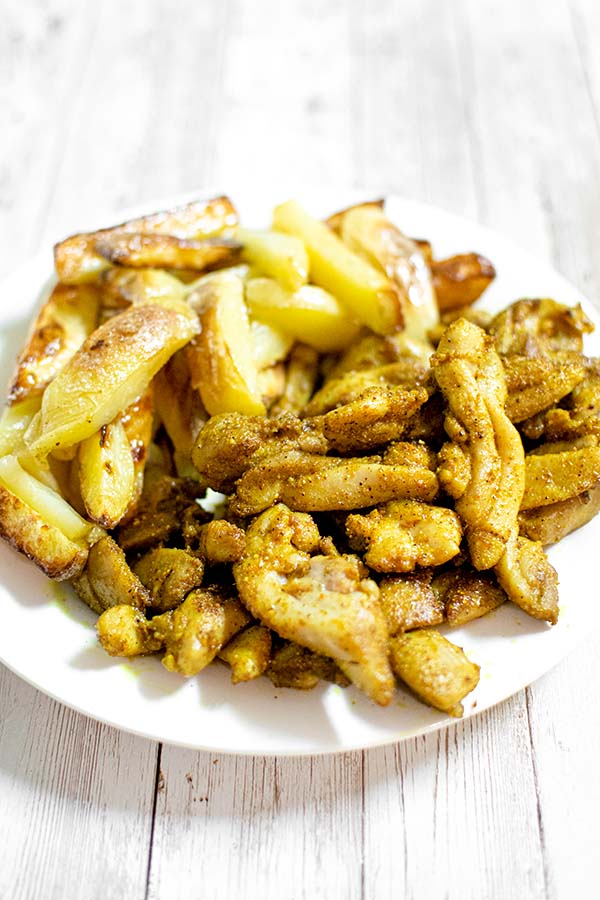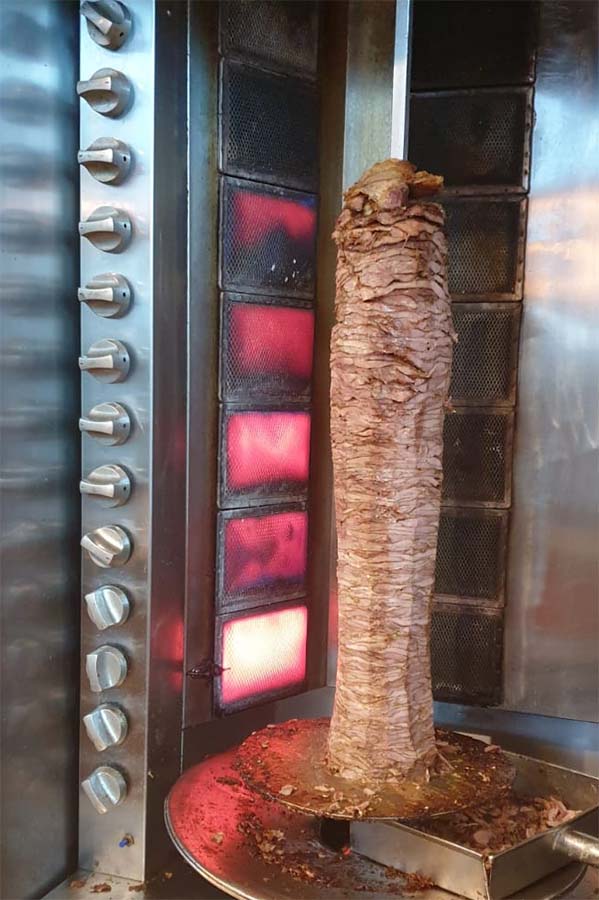This simple and quick to make delicious, Passover Chicken Shawarma recipe will allow you to bring this popular Middle Eastern street food to your home when you want an evening in alone or with family or friends or a quick lunch anytime during the week of Passover!
(Note: some kosher authorities consider some of the ingredients in the seasoning to be kitniyos (kitniyot) – please check with your own kosher authority).

Shawarma is a wonderful Middle Eastern street food. Nothing compares to the amazing taste of the meat that comes right off the skewer, especially when combined with the pita-fillers.
However, it is not always simple to find shawarma where one lives or to just pop out when one has a taste for it. It’s even harder, if not impossible, to find it kosher on Passover!
Therefore, with this Passover Chicken Shawarma recipe you can enjoy the taste of shawarma in your home!
A little background
When I was single, I would make the simplest things (like grilled cheese or boiled chicken in onion soup mix), so when I got first married, I had no idea how to cook. Over the years, I learned by asking and getting advice.
I never learned to actually like cooking, but I do so for my family and love my kids’ reaction when I make something they enjoy eating.
My kids consider me to be a very good cook. Why? Because everything I make is to their particular specifications. Every since they were little, I would make whatever anyone liked (there was no “if you don’t like it, have cereal”). Having six kids, I could easy make several dishes for a sit-down meal and was very happy when more than one of them wanted the same thing.
Besides, not liking to cook, I dislike going out even more. I used to like going out, until one day, I went out and couldn’t find anything reasonably priced on the menu that was something I couldn’t make on my own at home. So, I made a rule, if I can make it at home, I am not eating it out.
Shawarma was one of those things that I would eat out.
Then I came across Shawarma seasoning.
To be honest, I still eat Shawarma out, however sometimes a person wants to eat something and not have to drive to get it. Not to mention if you live in a place where it can’t even be considered local.
While I don’t like cooking much during the year, Passover brings with it a whole new set of challenges. This is true especially for Erev Pesach (the day before the seder) as we don’t eat anything that includes matza or matza meal until the seder.
Passover Chicken Shawarma is a perfect meal for that day or during the week.
A little about Israeli cuisine
Some people complain about cultural appropriation in cuisine when food from one country is attributed to another country.
However, national cuisine in itself is often a mingling of food from of a variety of cultures, often due to a change of ruling countries and a shifting of borders.
Turkish cuisine, for example, goes back to the Ottoman Empire and was a combination of several cultures under Ottoman rule.
When people move from country to country, they will take their cultures with them and their decendents may adapt their traditional cuisine with that of their new home and, if they don’t, others might.
Chinese food in US restaurants is quite often not really authentic Chinese, but American Chinese.
Americans have created a whole variety of types and styles of pizza and pineapple pizza was apparently created in Canada by a Greek immigrant. Yet, everyone still calls them all “pizza”, which originated in Italy.
Spaghetti is thought to be an Italian food, but many historians believe that it was brought back to Italy from China by Marco Polo.
Apparently, battered fried fish was from the Portuguese Jewish community as a sabbath food and ended up in England via Holland during the Spanish Inquisition, yet everyone attributes the food to the British.
…and don’t get me started on Hummus.
When one lives in a melting pot, such as the US or Israel, it is just unrealistic to expect that food from a particular culture won’t mingle with that of other cultures.
That being said, “Israeli cuisine” is basically Middle Eastern (as opposed to Eastern European food) that was brought to Israel by Jews when they fled or were expelled from Muslim countries and moved to Israel mostly after the declaration of the State of Israel (collectively known as Mizrahi Jews).
Recipes were passed from generation to generation and, although decades have passed, the foods are still known by the culture they came from and everyone seems to have their own way of making them.
That said, there are many variations of pretty much any “Israeli” recipe, because of background, custom, or even just taste. When choosing a recipe, one has to know what actually constitutes a main ingredient – what makes the dish what it is – and what is left up to individual taste.
I personally find it very arrogant and quite irritating when a blogger(not naming names) will put “authentic” in the title of an “Israeli” recipe, as if all the rest are mere imitations. What’s worse, is when that blogger makes the recipe with her own twist and then calls it authentic!
Adding more or less of a spice or adding a spice that is not in the recipe, does not make it less authentic, but calling it “authentic” and then adding unnecessary extra ingredients above and beyond what needs to be there, is misleading.
For example, “authentic” Israeli salad (what Israelis call Israeli salad) is diced tomatoes and cucumbers. Sometimes, they will add some oil salt and pepper, but THAT’S IT. Anything else does not have to be there, but if you leave out the cucumbers or the tomatoes, you no longer have an “Israeli salad”.
So, find the recipes you like with the ingredients you prefer, add your own twists, and בתאבון (literally translated, “with appetite”) !
A Little About Shawarma
Shawarma is a Middle Eastern meat dish that is a popular street food.
Shawarma’s origin is from the Doner Kabab from Turkey, whose modern cuisine developed from the Ottoman Empire. The Ottomans combined the adopted traditional dishes of the countries they ruled.
The Greek version of a shawarma is a Gyro.
Both names (Doner and Gyro) indicate turning or spinning and in fact the name shawarma comes from the Turkish form of the Arabic word for turn or spin.
Shawarma is made from different types of meat that can be used together to create it. These include, lamb, turkey, chicken, and beef.
While, for the most part, pork is not eaten in the Middle East, the gyro is often made of chicken or pork.
The different types of seasoned meat are sliced and skewered in tight layers on a vertical rotisserie or spit with layers of fat at the top. The skewer rotates vertically and slowly near a heat source and the fat melts over the meat giving the meat a wonderful flavor as lightly roasts on the outside.
Shawarma is a popular street food in the Middle East and it seems that every country has their own traditional way of eating it.
In Israel, it will normally be served in a pita or in a laffa (an Iraqi flatbread that is part of Israeli cuisine) together with a variety of additions, such as tahini, humus, pickles, Israeli salad (diced cucumbers and tomatoes), French fries, pickled cabbage, and more. Everyone just puts in what they like.
Of course, for Passover, one would eat it on a plate with their favorite sides or in a matza sandwich!

Tips for making Passover Chicken Shawarma at home
- Note that some kosher authorities consider some of the ingredients in the seasoning to be kitniyos (kitniyot) – please check with your own kosher authority).
- The shawarma can be put in the oven and baked until ready, but I like using a frying pan and stirring for more control.
- The dominant taste of shawarma seasoning is the cumin. Everyone seems to have their own taste as far as the seasoning is concerned, so feel free to add more of it (or just more cumin) if you like it that way.
- I use fat instead of oil when I can to replicate the fat used on the rotisserie and add more while cooking if I feel the mixture is not greased enough, but oil is fine and to each his own (I personally don’t eat the shawarma with the extra oil or fat, but my sons – who don’t care about calories – like it that way).
- When chicken is used to make shawarma, it is the the dark meat of the chicken and that is why chicken thigh fillets are called for. However, in a pinch, if you don’t have chicken thigh (or if you don’t like it), you can substitute strips from another part of the chicken.
- Feel free to use left over chicken for this recipe, just make sure it is not too dry or the shawarma pieces may fall apart (yes, that did happen to me). It will still taste good, but won’t look as appetizing.
Passover Chicken Shawarma

Simple and delicious shawarma from scratch.
Ingredients
- 1 pound skinless, boneless chicken thigh, sliced into small strips
- 2 tablespoons (or more if desired)* of Passover Shawarma Seasoning Mix
- schmaltz or oil (kosher for Passover)
Instructions
- Place the shawarma seasoning mix in a bowl, add the chicken strips and coat well.
- Grease a frying pan well and heat.
- Place the strips in the frying pan and stir as it cooks.
- Cook for approximately 10 minutes or until turkey strips have cooked through.
Notes
* Some kosher authorities consider some of the ingredients in the spice to be kitniyot (the CRC considers the cumin to be kitniyot and the OU doesn't). Please check with your own kosher authority.
Nutrition Information:
Yield:
4Serving Size:
1Amount Per Serving: Calories: 193Total Fat: 9gSaturated Fat: 3gTrans Fat: 0gUnsaturated Fat: 6gCholesterol: 140mgSodium: 301mgCarbohydrates: 1gFiber: 0gSugar: 0gProtein: 28g